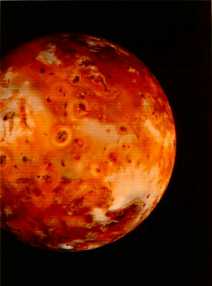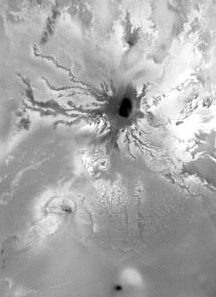This is an image of Io.
Click on image for full size
NASA
Io
Io was first discovered by Galileo in 1610, making it one of the
Galilean Satellites. Of the 60 moons it is the 5th closest to Jupiter, with a standoff distance of 421,600 km. It is the 4th largest moon of Jupiter, with a diameter about 2/3 the distance across the United States, of 3630 km (2256 miles).
Io is named after one of Jupiter's many lovers, from Roman mythology. It is the only moon known to have active volcanism, which is visible on the surface.
Io is mostly made of sulfur, iron, and silicates, which means that Io is nothing at all like the other icy satellites of Jupiter, and has had a very different evolution.
The particles comprising Io's atmosphere readily find their way into the magnetosphere, and create a donut-shaped cloud called the torus. This cloud has a very profound effect on Jupiter's magnetosphere.
Because of all the volcanic activity, the environment of Io is pretty inhospitable to life as we know it.
You might also be interested in:

How did life evolve on Earth? The answer to this question can help us understand our past and prepare for our future. Although evolution provides credible and reliable answers, polls show that many people turn away from science, seeking other explanations with which they are more comfortable.
...more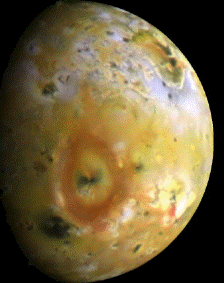
The surface of Io is completely volcanic, with lava flows of sulfur from the interior, as shown in this image. White patches in the image indicate areas of surface SO2 frost. The heat for this volcanism
...more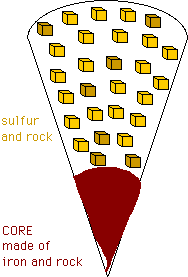
Io's atmosphere is roughly 90% Sulfur, and 10% other simple atoms such as Oxygen. If it can be seen, the constituents of a surface are generally determined by detailed observations of spectra. These measurements
...more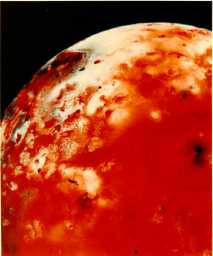
Io is the smallest of the major Galilean satellites, with a size that could be that of the rocky core of one of the other Galilean moons. Io is heated through the process of tidal forcing, which causes
...more
In spite of the fact that Io has an atmosphere, the environment of Io seems pretty unfriendly toward life as we know it on earth. Io is very small, so there is not much gravity. For this reason, the atmosphere
...more
In the foreground of this image is shown the geyser, Pelee.
...more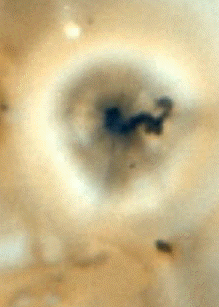
This is an image of the geyser, Prometheus. The black marking in the center of the image is the mouth of the geyser. This opening is encircled by a pool of material.
...more


